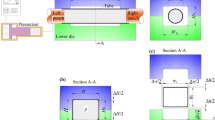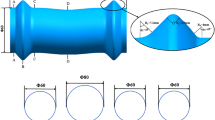Abstract
Hydroformed tubular parts have been widely used in a variety of applications requiring high strength and high dimensional accuracy. However, the essence and strategy for controlling dimensional accuracy of the parts have not been given an in-depth investigation. In this paper, a strategy for compensating the springback of hydroformed tubular parts is proposed to improve their dimensional accuracy. It is believed that the parts have the highest dimensional accuracy when the expansion amount of die cavity is exactly equal to the springback of tubular part by controlling the internal pressure. The theoretical calculation formula of target pressure is firstly derived under the assumption of axisymmetric plane strain without considering the influence of clamping force. The proposed control strategy was then implemented experimentally to validate its feasibility. It is shown that the diameters of SAPH440 tubular parts increase linearly with increasing internal pressure from 60 to 240 MPa. After unloading and removing the tubular parts from die cavity, a certain springback will occur on the parts. When the internal pressure reaches the target pressure of 150 MPa, the diameter of final part is exactly equal to the target value. Moreover, due to the inevitable effect of clamping force in experiments, the target pressure in the experiment is lower than that from theoretical prediction. Finally, it is further proved by repeated experiments that the diameter deviation of tubular parts can be controlled accurately within range of [-0.05 mm, + 0.05 mm]. These results provide theoretical basis and technical support for precision manufacturing of key components for automobile and aerospace.














Similar content being viewed by others
Abbreviations
- d 0 :
-
Initial diameter of tube blank
- t 0 :
-
Initial thickness of tube blank
- t :
-
Thickness of tubular part
- r :
-
Radius of tubular part
- D :
-
Diameter of tubular parts (die cavity) under pressurization
- D 0 :
-
Design value of the diameter of die cavity (design value of the diameter of final hydroformed tubular parts)
- D 1 :
-
Diameter of final hydroformed tubular parts
- ∆D′:
-
Expansion amount of die cavity
- ∆D :
-
Springback of tubular parts
- p :
-
Internal pressure
- p′:
-
Contact pressure between the outer surface of tube blank and the surface of the die cavity
- p cr :
-
Calibration pressure. When \(p={p}_{cr}\), the tube blank is just attached to the die cavity, and the die has no elastic deformation.
- \({p}_{cr}^{\mathrm{^{\prime}}}\) :
-
Target pressure, \({p}_{cr}^{^{\prime}}>{p}_{cr}\). When \(p={p}_{cr}^{^{\prime}}\), the diameter expansion amount of die cavity is equal to the springback of tubular parts.
- K :
-
Strength coefficient of tube blank
- n :
-
Strain hardening exponent of tube blank
- σ s, σ b :
-
Yield strength and tensile strength of tube blank
- \({\sigma }_{si}^{\mathrm{^{\prime}}}\) :
-
Flow stress of tube blank
- η max :
-
Ultimate expansion ratio of tube blank
- σ se :
-
Yield strength of die material
- \({\sigma }_{se}^{\mathrm{^{\prime}}}\) :
-
Flow stress of die material in elastic stage
- σ θ, σ r :
-
Circumferential and radial stresses of tube blank
- σ θ d, σ zd, σ rd :
-
Circumferential, axial and radial stresses of die
- C :
-
Integration constant
- r i, r e :
-
Inside radius and outside radius of tube blank
- R :
-
Radius of die
- R i, R e :
-
Inside radius and outside radius of die if it is equivalent to a thick-walled cylinder
- u r :
-
Elastic displacement of die cavity in radial direction
- E :
-
Elasticity modulus of tube blank
- E e :
-
Elasticity modulus of die material
- μ :
-
Poisson's ratio of die material
- ∆ε i :
-
Springback strain of tubular parts after unloading
References
Bell C, Corney J, Zuelli N, Savings D (2020) A state of the art review of hydroforming technology. Int J Mater Form 13:789–828. https://doi.org/10.1007/s12289-019-01507-1
Iorio L, Maspero E, Strano M (2014) Hydroforming of locally heat treated tubes. J Manuf Process 16:157–165. https://doi.org/10.1016/j.jmapro.2014.01.002
Han C, Liu Q, Lu H et al (2018) Thickness improvement in hydroforming of a variable diameter tubular component by using wrinkles and preforms. Int J Adv Manuf Technol 99:2993–3003. https://doi.org/10.1007/s00170-018-2684-4
Vollertsen F (2000) Accuracy in process chains using hydroforming. J Mater Process Technol 103:424–433. https://doi.org/10.1016/S0924-0136(00)00507-0
Leitloff UF (1998) Sizing up-quality aspects in hydroforming. In: Proceedings of the Second International Hydroforming Congress. Nashville, Tennessee
Morphy G (1998) Tube hydroforming: Dimensional capability analysis of a high volume automotive structural component production process. In: SAE Technical Papers
Xie WC (2018) Research on hydroforming behavior of thin-walled welded tubes with irregular sections (in Chinese). Harbin Institute of Technology
Cai Y, Liu Q, Wang XS, Yuan SJ (2015) Thickness distribution and size deviation of 6063 alloy irregular tubular parts prepared by hydroforming. Zhongguo Youse Jinshu Xuebao/Chinese J Nonferrous Met
Liu Z, Lang LH, Ruan SW et al (2019) Effect of internal pressure assisted on hydroforming for CP800 high-strength steel torsion beam. J Braz Soc Mech Sci Eng 41:90. https://doi.org/10.1007/s40430-019-1570-9
Imaninejad M, Subhash G, Loukus A (2005) Loading path optimization of tube hydroforming process. Int J Mach Tools Manuf 45:1504–1514. https://doi.org/10.1016/j.ijmachtools.2005.01.029
Chen MT, Xiao XT, Tong JH et al (2018) Optimization of loading path in hydroforming of parallel double branched tube through response surface methodology. Adv Eng Softw 115:429–438. https://doi.org/10.1016/j.advengsoft.2017.11.003
Nakamori T, Shukuno K, Manabe K (2017) In-process controlled Y-shape tube hydroforming with high accurate built-in sensors. Procedia Eng 184:43–49. https://doi.org/10.1016/j.proeng.2017.04.069
Lee YS, Lee JH, Kwon YN, Ishikawa T (2004) Analysis of the elastic characteristics at die and workpiece to improve the dimensional accuracy for cold forged part. J Mater Process Technol 153–154:1081–1088. https://doi.org/10.1016/j.jmatprotec.2004.04.291
Hartl C, Anyasodor G, Ptaschlik T et al (2010) Investigation into reduction of die-cavity deflection in micro-hydroforming processes using FEA. Int J Adv Manuf Technol 47:853–858. https://doi.org/10.1007/s00170-009-2141-5
Xie W, Yuan S (2017) Bulging behavior of Thin-walled welded low carbon steel tubes (in Chinese). J Mater Eng 45:72–77. https://doi.org/10.11868/j.issn.1001-4381.2015.000312
He Z, Yuan S, Lin Y et al (2014) Analytical model for tube hydro-bulging tests, part II: Linear model for pole thickness and its application. Int J Mech Sci 87:307–315. https://doi.org/10.1016/j.ijmecsci.2014.05.010
Cui X, Wang Y, Wen S, Xu W (2022) Influence of clamping force on dimensional accuracy of variable-diameter tubular part in hydroforming (in Chinese). J Netshape Form Eng 14:12–18
Acknowledgements
The authors wish to express their gratitude to the funding supports from the China Postdoctoral Science Foundation (No. 2020M670907), the foundation of National Key Laboratory for Precision Hot Processing of Metals, Harbin Institute of Technology (JCKYS2021603C002), the National Natural Science Foundation of China (No. 51805357), and the Heilongjiang Postdoctoral Fund (No. LBH-Z20017).
Author information
Authors and Affiliations
Ethics declarations
Conflict of Interest
The authors declare that they have no conflict of interest.
Additional information
Publisher's Note
Springer Nature remains neutral with regard to jurisdictional claims in published maps and institutional affiliations.
Rights and permissions
Springer Nature or its licensor (e.g. a society or other partner) holds exclusive rights to this article under a publishing agreement with the author(s) or other rightsholder(s); author self-archiving of the accepted manuscript version of this article is solely governed by the terms of such publishing agreement and applicable law.
About this article
Cite this article
Cui, XL., Han, C., He, J. et al. Springback behavior and control strategy for dimensional accuracy of hydroformed tubular parts. Int J Mater Form 16, 15 (2023). https://doi.org/10.1007/s12289-023-01736-5
Received:
Accepted:
Published:
DOI: https://doi.org/10.1007/s12289-023-01736-5




